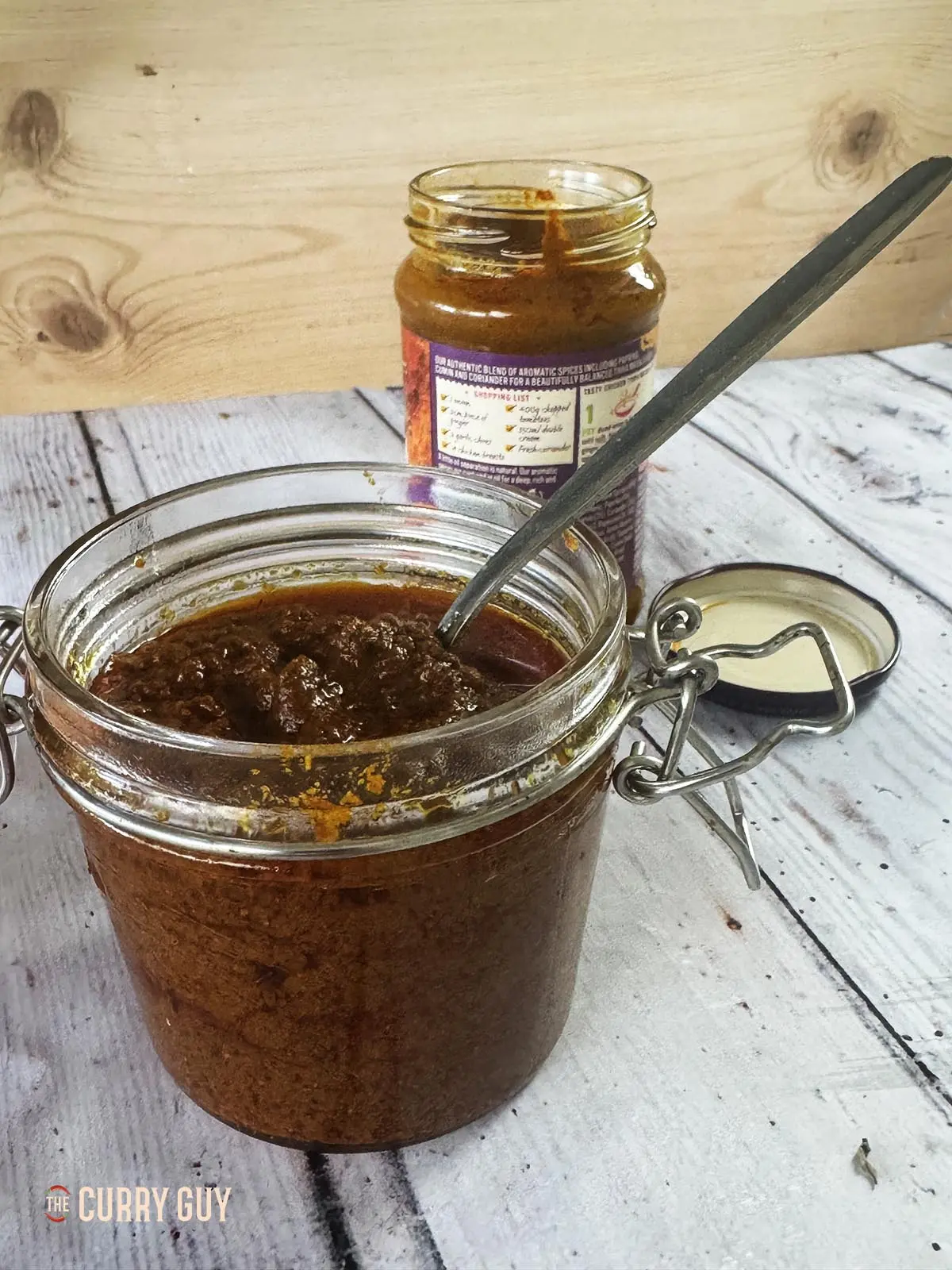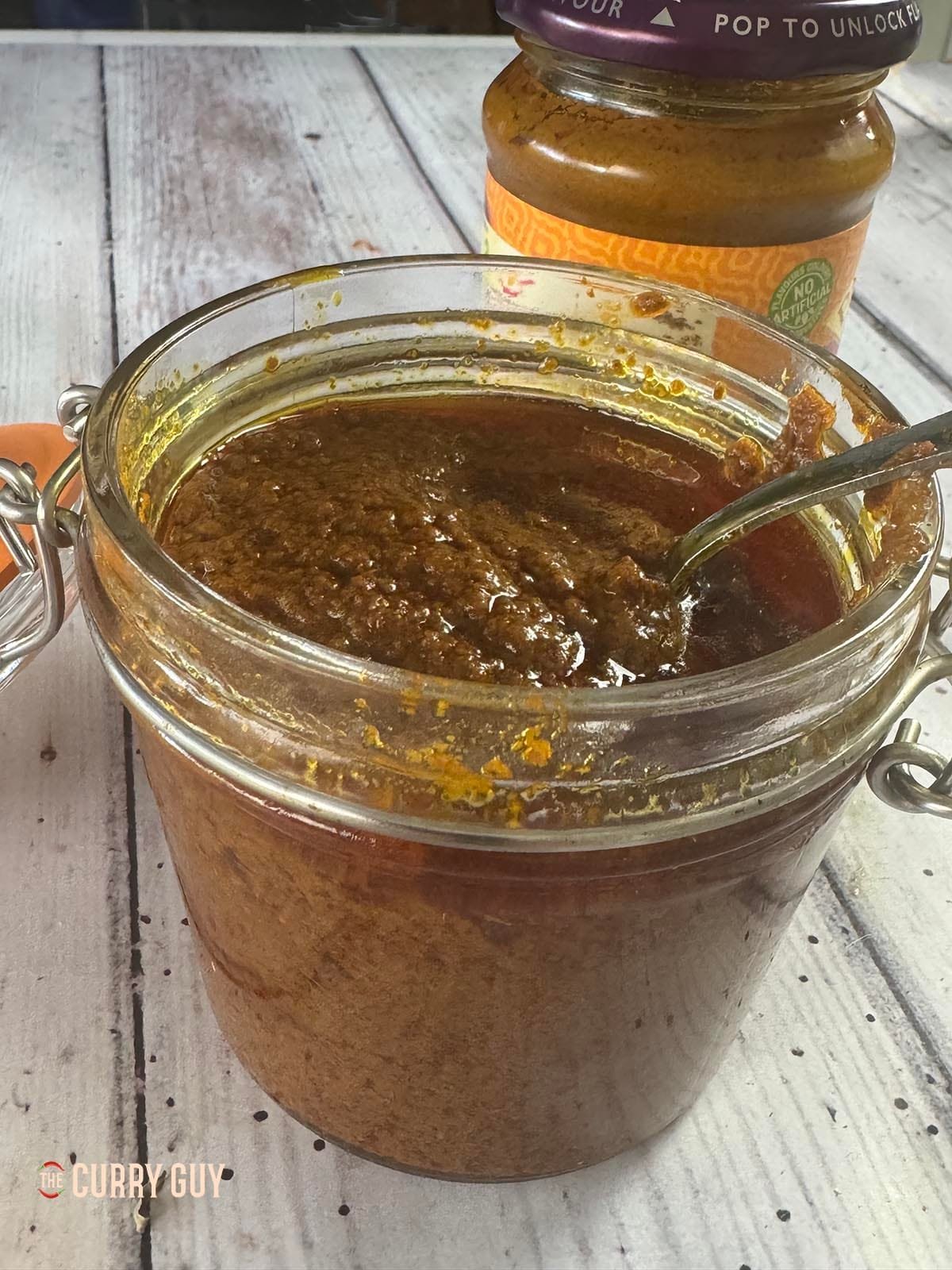Sharing is caring!
This tikka masala paste will achieve better results than anything you can purchase in a jar.
I am often asked why my recipes call for so many ingredients. Why not just use a jar of curry paste? Well, some of the lower quality curry houses do exactly that but the good ones add spices individually so that they can produce the flavour they are going for. Still, I know that some people want an easy good, so rather than reaching for that jar of tikka masala paste when you next shop, why not try making your own? It’s far superior!


About this tikka masala paste recipe.
I am currently working on developing a few recipes for popular curry pastes. In this tikka masala paste recipe, you roast and then grind your own spices which really brings out their flavour. Unlike many brands, you can actually taste the spices and that is so important when making a curry.
To make my curry pastes, I purchased a few of the most popular pastes from a few different brands. I tasted them and then went to work developing my own versions and comparing their flavour to the commercial brands. I promise you… your homemade tikka masala paste will be far better than the commercial brands.
How is this tikka masala paste different to what you can purchase?
When you compare my tikka masala paste to the popular brands, you will notice that it isn’t as tangy. If you try the popular brands, you might notice that they taste so tangy you can hardly taste the spices!
I wanted to ensure that wasn’t the case with my pastes. You can achieve tangy flavours when you prepare your curry by adding a drop more vinegar, lemon juice, lime juice or tamarind. So add those to taste while you are cooking but let those spices stand out.
The commercial brands tend to use a lot of acetic acid, most likely in the form of citric acid and you sure can taste it. It’s overpowering!
Who would want to make their own curry paste?
There are pros and cons to using a curry paste. The pros are that they are convenient to have on hand and they can be used not only as a substitute for adding spices individually but they can also be added in small amounts at the end of cooking any curry. Curry house chefs do this often as a bit of a flavour booster.
The cons are that using a commercial brand, all of the different spice blends tend to taste very similar. The overriding flavour is citric acid. If you make your own using this recipe, that will not be the case.
There is one more pro to making this tikka masala paste. You roast and grind whole spices and the depth of flavour is so much better than adding spices that have not been roasted. If you add ground cumin or ground coriander to a curry, chances are those ground spices were never roasted unless you did it yourself.
How do you use this tikka masala paste?
If you follow one of my recipes such as chicken tikka masala, you just leave all the spices out of the recipe but add everything else.
When the spices are added in the instructions, add this homemade tikka masala paste instead. A good rule of thumb is to add half a batch for a curry that serves 4 or a quarter of a batch for a curry that serves 2.
You can always stir in a little more at the end of cooking and cook to taste.
Do you have to use that much oil?
No. You add the oil and vinegar to help preserve the paste for longer. If you are using the paste within a few days, you could leave the oil out completely. I do add some vinegar for flavour even if using immediately.
Will this tikka masala paste make a curry that tastes just like your chicken tikka masala recipes?
No. I developed this recipe so that it tastes better than anything you can purchase in a jar at the shop. It will make a good chicken tikka masala and can also be used to make other curries as the spices used in other curries are often similar.
Making this paste, you will have a convenient and homemade way to make a quick curry without the need to go measuring out all your spices.
Are there other uses for this tikka masala paste?
Yes! You can add about 3 tbsp to 125ml (1/2 cup) yoghurt and whisk it all together. This will give you a delicious marinade for meats, fish and vegetables. You could also add about one tablespoon to the same amount of yoghurt to make a quick and easy raita.
How long can you store homemade tikka masala paste?
You will be able to keep this in an air-tight container in the fridge for at least three months with little loss of flavour. You can also freeze it in convenient sized portions. For your information, the recipe makes enough to make two curries that serve four.
Step by step photographs.


Get all your ingredients together before starting. It’s easier that way.


Roast the whole spices in a pan over a medium heat until fragrant and warm to the touch but not yet smoking.


Transfer the roasted spices to a plate to cool and then pour them into a spice grinder or pestle and mortar.


Grind these spice to a very fine powder.


Add the ground ingredients and dried herbs and blend them in.


Pour this blend into a pan over a medium heat.


Stir in the water and tamarind concentrate to make a paste.


Add the oil and bring to a simmer, while stirring continuously.


The oil will rise to the top after 30 to 60 seconds. When it does, add the vinegar and turn off the heat.


Transfer the spices to a clean preserve jar, leaving most of the oil behind.


Once all the spices are in the jar, you can spoon some or all of the oil over the top to help preserve the paste.


Use as needed. This will keep in the fridge for months and can also be frozen in plastic freezer bags.


This is great to have on hand for that last minute curry craving.
Prep Time
10 minutes
Cook Time
5 minutes
Total Time
15 minutes
Ingredients
4 tablespoons cumin seeds
4 tablespoons coriander seeds
1 tablespoon black peppercorns
1 tbsp paprika
1 tbsp Kashmiri chilli powder (more or less to taste) or more paprika
1 tsp amchoor (dried mango powder) or citric acid powder
½ teaspoon turmeric powder
½ tsp ground ginger
1 tsp ground garlic
1 tbsp kasoori methi (dried fenugreek leaves)
1 tbsp dried coriander leaves
1 tbsp tamarind concentrate
125ml (1/2 cup) rapeseed (canola) oil (plus more if required)
70ml (1/4 cup) distilled or white wine vinegar
Salt to taste (I usually leave it out and add salt when cooking)
Instructions
- Heat a frying pan over medium high heat. Pour the whole spices into the pan and roast until warm to the touch and fragrant but don’t let them smoke. Remove the spice from the heat to cool on a plate and then place the spices in a spice grinder or pestle and mortar and blend to a fine powder.
- Stir in the paprika, chilli powder, amchoor or citric acid, turmeric, ground ginger, ground garlic, kasoori methi and dried coriander leaves, if using.
- In a frying pan, mix this powder with the tamarind concentrate and about 100ml (1/3 cup) of water and stir into a paste over a medium heat. Pour the oil into the pan turn the burner up to medium-high. Stir continuously until the spices begin to sizzle a bit and the oil all rises to the top. 30 seconds to a minute should be enough as you have already roasted the spices.
- Turn off the heat and add the vinegar and stir it all up nicely. Spoon the spice mixture into a very clean preserve jar with an air-tight lid. This will keep in the fridge for at least three months.
Recommended Products
As an Amazon Associate and member of other affiliate programs, I earn from qualifying purchases.
Nutrition Information:
Yield:
8
Serving Size:
1
Amount Per Serving:
Calories: 183Total Fat: 19gSaturated Fat: 1gTrans Fat: 0 gUnsaturated Fat: 16gCholesterol: 0 mgSodium: 88mgCarbohydrates: 5gFiber: 2gSugar: 1gProtein: 1g




